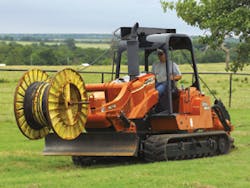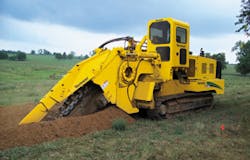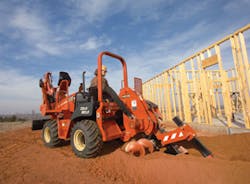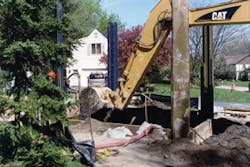Lebanon Limestone, the rock lying under 6 to 8 inches of Tennessee topsoil, typically requires blasting, but where blasting is prohibited, Eddie Conrad, owner of Conrad Construction Co., says trenchers are “handy.”
Fort 35 years, the family business with 33 employees, located in Nashville, TN, has specialized in building roads and infrastructure-primarily water and sewer lines. Conrad, who does $3 million-$4 million in business annually, has put in water and sewer lines to the cities of Lebanon and Hendersonville and works for various municipalities.
“We used to blast,” Conrad admits. “It made life easier.” However, the threat of litigation from potentially damaged homes and businesses complicated the ease of blasting. Because the rock is weathered, Conrad explains, a blast can cause fissures or caverns-and the resulting shock waves often do additional damage.
These days, Conrad more often uses a Vermeer trencher to do the job. “Trenching takes longer than blasting, but it does a neater job.” How long it takes depends on the rock’s density. Hard rock cuts better than dense rock.
Trenching Versus Blasting
Despite Conrad’s opinion that trenching takes longer, in many situations, trenching can be the quicker, more efficient option. Although blasting through hard rock was long considered the favored way of excavating for a pipeline, contractors across North America are discovering, as Conrad has, that trenching offers many advantages.
Blasting disturbs nearby structures and fractures the rock, but trenching cuts a smaller, neater path, with less ground disturbance. That also reduces liability.
Additional material for backfill is typically needed when blasting. Cutting through several layers of soil in a single pass, a trencher excavates the spoil, which can often be used as backfill material.
Blasting results in irregularly shaped walls requiring additional excavation. Irregular walls resist compaction. Trench walls are vertical, minimizing excavation, and have consistent dimensions. Uniform walls aid compaction. The flat-bottom trench is straight, at a controlled grade.
Blasting leaves a wider opening that requires more surface patching-and at greater cost. In addition, as the surrounding structure settles, surface sinking can occur. A small opening at the top of the trench conserves patching materials and reduces the amount of finishing required.
Safety is increased when trenching in close proximity to other infrastructure or in urban settings, once again reducing the risk of liability.
“Safety is 90% of getting the job done,” Conrad states. “If the job kills you, there’s not much profit.” He is able to safely cut a ditch up to 22 feet in depth in the vicinity of high-pressure gas mains. The trencher leaves a “slick-face rock when cut. It’s a safe place. Even OSHA recognizes the safety of a rock wall.”
Because of the increased focus on environmental issues and a growing number of restrictions and regulations, rock trenching is eclipsing blasting and hammering, both of which can produce unpredictable results, often at greater cost.
Another Vermeer customer, Dave Rice, owner of Las Vegas-based Rice Construction Co. Inc., prefers trenching to blasting because it produces rock smaller than 1 inch in diameter that can be used to fill the ditches. He’s also happy that production increased by nearly five times when he replaced a 60-ton, 400-horsepower trencher with a Vermeer T1255 Commander. Not only is it the largest production track trencher available, the 90-ton unit puts out an additional 200 horsepower-essential, Rice says, for cutting through stone and caliche in the residential areas of southern Henderson, NV.
Trenching eliminates many of the liabilities associated with blasting, including increased insurance.
Rice’s crew installed a 10-inch water main approximately 13 feet deep throughout the 623-acre development at McDonald Ranch called the Canyons. His previous trencher got 30-40 feet per day, but he reports getting 10 times that amount with the T1255. Equipped with the Vermeer Trencher Electronic Control (TEC 2000) system, the T1255 is automatically adjusted to varying conditions.
Trenching offers many desirable advantages for all contractors. It eliminates many of the liabilities associated with blasting, such as increased cost of insurance, bonds, and permits due to higher safety risk; additional debris and hauling; risk of high rock explosions; intrusive method that isn’t permitted everywhere; additional filling material and backfill requirements; increased wear and tear on equipment; and limited access. Other benefits offered by trenching include low environmental impact and increased speed and efficiency. A precise, controlled path can be cut, and, because other crews can continue working simultaneously, trenching saves time and money.
Choosing the Right Equipment
The work environment for trenchers is tough, rugged, and dirty. It’s imperative to match the equipment to the conditions and meet the demands of the job. Equipment features to look for include durability, flexibility, reliability, efficiency, economy, and operator comfort. Urban projects require additional maneuverability and add to the shopping list of necessary features.
The 60-horsepower RT55 is designed for the toughest, tightest landscapes, says Greg Adkins, trenching product manager for Ditch Witch in Perry, OK. Equipped with a quiet Deutz engine, the compact, powerful, versatile trencher works efficiently in urban settings.
Ditch Witch, which sells 50% of all trenchers worldwide, invented the first walk-behind trencher in 1949. It all started with the local plumber, Adkins explains, and getting him from the street to the house. Today, the company caters to contractors, municipalities, water and sewer companies, and rental yards with its three main product lines: trenchers, ploughs, and hydraulic saws, all hydrostatic-driven.
Well adapted for urban jobs is the RT115, a 4WD turbocharged heavy-duty tractor featuring a 115-horsepower John Deere engine and hydrostatic transmission, although Adkins says it’s also available in a power-shift version, a unique feature. “Most of the industry uses hydrostat or mechanical for performance efficiency,” he elaborates.”
The HT115 is a hydraulic-track version of the rubber-tired powerhouse. Its one-piece rigid frame design increases capacity and endurance. An optional tilt-frame configuration assists in digging vertical trenches on uneven ground. Dual steering helps in “crabbing” on slopes to maintain a better plow path and to keep from drifting down. It’s also available with a rear-steer option that enables tight turns for urban settings.
Versatility is the key to the market, believes Tony Bokhoven, track solutions specialist with Vermeer Manufacturing Co., and is driven by competition with the excavator market. But while he says Vermeer is looking for additional capability, he cautions, “We’re not trying to build a Swiss Army knife. We’re trying to get the machine to be more versatile but not be everything.”
From the 755 to the 1455 (the largest available), Vermeer’s hydrostatic trenching units offer high torque and horsepower, can dig to deeper depths, and feature flexibility for varying work conditions. The large head-shaft motor is designed to produce full horsepower all the time. Hydrostatic transmissions engineered by Vermeer deliver high torque without losing horsepower due to torque converters.
Able to operate at full load at any chain speed, durable, heavy-duty track chains can operate at a range of cutting speeds, allowing an operator to match the machine to the conditions. Vermeer provides customized baseplate configurations and has developed a digger chain specifically for trenching applications.
Attachments play an important role in getting the job done. Ditch Witch offers several attachments for its line of ride-on tractors for contractors. A chain saw for the trencher cuts to specific depths and widths. Vibratory ploughs are useful for cable and waterline drops. “We developed cut-tooth technology on our digging chain. The blade goes in the ground 2 to 4 feet,” Adkins says. “As the blade cuts, the vibrator vibrates the blade to put the product in the ground. It creates less disturbance in the earth.”
Saws reach depths of 18 to 36 inches. Rock bits on the cutting wheel chew through asphalt, concrete, and rock. “There are many chains available for a trencher; the cut tooth is for dirt only,” he says. “The rock chain is for rocky conditions; it has a carbide tip rock bit.” There’s also a combination chain.
Ditch Witch offers mechanically driven digging attachments. Adkins points out that most brands use belts and gears. “We use a torque converter to give mechanical efficiency with the flexibility of hydraulics (fluid coupler). Contractors like mechanical-driven. Hydraulic is user-friendly, but it’s the least efficient. Utility companies like it.”
Vermeer recognizes the importance of easy plug-in, plug-out versatility. When the 1250, for example, costs $1.7 million, “you need the ability to convert it to a trencher to continue to use a tractor,” Bokhoven says. That’s why the same boom head holds all attachments. “It’s a unique feature,” he states. “For the upper-end 850 and up, attachments are interchangeable between the trencher and the train leveler without huge modifications to the machine. It increases uptime.”
Vermeer is working on a new bucket wheel attachment for the T655 Commander 3, popular for wind farms and cross-country gas pipeline applications where the ground is hardpan cobble. Bokhoven says their focus is currently on the bucket wheeler, versatility and ease of use.
Other things Vermeer is concentrating on include productivity and operator comfort. “We stepped back to make our machines more productive,” Bokhoven relates. One step toward that is the introduction of the T1155 Commander 3 trencher, which can reach greater depths and widths. But for current models, that step involves adaptation to Vermeer’s TECplus system. The company’s exclusive, patented TEC 2000 and TEC 2000.2 control systems monitor operating conditions, increase productivity, and reduce machine wear. In addition to providing an integrated electrical system for automated control, they also work as diagnostic tools.
“We’ve taken 1,000 feet of wire out of the machine,” Bokhoven states. “It had a big wiring harness; that was troublesome.” Vermeer also positioned multiple computers around the equipment in order to more easily detect issues. “We can zero-in quickly. That cuts down trouble-shooting time and is more efficient. The operator can give the information over the phone to tech support and get problems resolved quickly.”
Vermeer has also sought to enhance the experience in the cab in order to go after the excavator market. Attention has been paid to operator comfort: air-ride seats; an ergonomically designed, bigger cab; and a larger screen on the dash that’s easier to see and simpler to operate. Elevating and extending cabs and placement relative to the digging boom are designed to provide the operator with better visibility. Another important aspect, Bokhoven believes, is that operations are consistent. “There’s very little time to train operators to cut ditches efficiently, so the controls are the same in all Vermeer machinery.”
Likewise, from the smallest walk-beside Ditch Witch machine to the largest, the operator controls are color-coordinated the same way. “Every feature is color-coordinated on all the machines, no matter the size,” Adkins confirms. “That way, as people switch from one machine to another, they know where the controls are. It’s a safety feature as much as a convenience.”
Safety is an important issue, but operator fatigue “is a very big issue,” Adkins continues. “The balance of the machine is extremely critical so
The 60-horsepower RT55 from Ditch Witch is designed to operate in the toughest landscapes.
the machine takes abuse, not the operator.” Their trenchers accommodate kickback when they hit rock, softening the impact on the operator. Ditch Witch offers other user-friendly features like cruise control to let the operator maintain and monitor performance.
Service After the Sale
Finding good service is as important as finding the right features. Because Conrad started with an “old 800 Vermeer trencher in early 1980s,” his expanded fleet consists solely of Vermeer products. “My policy is it’s easier to maintain one brand; you dance with the one who brought you. Trying to master the mechanics on one brand is easier than starting with other brands.”
Bokhoven likes to talk about “value-added services that aren’t steel and engine,” such as the company’s rock lab. “It’s a valuable tool that lends credibility to the numbers we generate.” Rock sampling is a proprietary, free service for Vermeer customers who send in rock from a job site. Vermeer takes core samples, tests them, and, using their solutions calculator, figures the machine cost. “It narrows down the costs for a more accurate bid. Contractors need to know the condition of the rock to make an accurate bid and select the proper equipment for the job.”
Adkins recommends talking to equipment dealers in the area about local conditions. “In a lot of areas, you run into multiple ground conditions. Use your local [Ditch Witch] dealer; he knows the local ground conditions and can recommend the right equipment.” For instance, in dusty/dry conditions, a dealer might advise putting on a heavy-duty air-filtration system. Ditch Witch offers secondary filters on smaller units. When an air-cooled engine is close to the ground, Adkins says, it’s optional.
Maintenance is a perennial after-the-sale concern. Adkins says routine maintenance on Ditch Witch trenchers is simple and minimal. There’s no daily maintenance for gear bushings, unlike steel bushings, which need grease and daily flushing because they attract dirt. Some machines, like the RT95 power-shift tractor, offer a “huge advantage” to contractors through the elimination of belts (wear items) and the mechanical transfer of power. “The cost-saving performance of our machines improves productivity and consequently reduces dollars per foot.”
Trenches must be shored while contractors are working. Slide-rail systems can go where others can’t.
Walled In
Trenches need to be shored while contractors are working. A slide-rail system from Efficiency Production Inc. in Mason, MI, goes where other systems can’t, claims James McRay, marketing. “It’s an alternative to tight sheeting. Traditional excavation with vertical walls is tight sheeting; it requires special machinery to pile or vibrate into the ground, which might be prohibited near hospitals or historical areas. The slide rail system works well around utilities, buildings, railroad tracks and other structures.”
Built in America, it was refined based on the needs and job conditions of American contractors. “We thought through different situations, installation projects, and applications,” McRay explains.
He calls it the most flexible, easiest system to install. The steel component system of panels and posts is put together one piece at a time. Lightweight and adjustable, they can be sized in any configuration.
The pieces are manageable, take up less space and can be handled by midsize excavator and two or three operators. “There’s no need to rent bigger equipment to lift it.”
EPI offers three basic systems:
- The four-sided pit expands to up to 20 square feet.
- The clearspan system can be configured in infinite sizes up to 64 feet by 50 feet. “There are no cross-members,” McRay says. “It’s an open excavation area … or a huge lift station.”
- The linear multiple bay system consists of flexible cross-members for working next to utilities. The parallel beams with 24-foot rollers are highly reusable, as they “leap frog” over new sections.
Underground contractors prefer an unobstructed field, McRay points out, but it’s not always possible. “It’s more and more rare, especially as contractors get involved with updating and repairing infrastructure.” But, he concedes, there is more and more of this type of work in our shrinking world.
So, contractors are turning to these rail systems because a shored trencher pit is safer and these can be installed and removed faster than any other shoring system. In addition, the steel construction provides a long life, and the installation creates only minimal vibration, so they are highly adaptable to urban or other sensitive areas.






